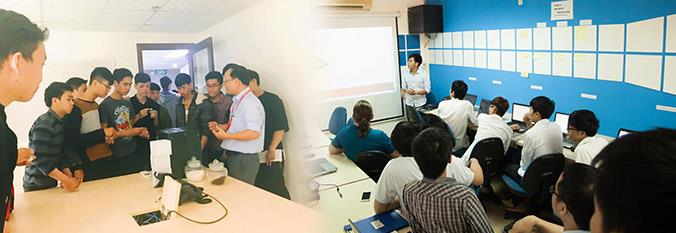Inventory control
Definition Of Inventory
Inventory is the stock of any item or resource used in an organization.
Manufacturing inventoryrefers to items that contribute to or become part of a firm’s product output. Manufacturing inventory is typically classified into raw materials, finished products, component parts, supplies, and work-in-process.
Inservices, inventory generally refers to the tangible goods to be sold and the supplies necessary to administer the service.
An inventory system is the set of policies and controls that monitor levels of inventory and determine what levels should be maintained, when stock should be replenished, and how large orders should be. A starting point and allow us to use a simple example.
Purposes Of Inventory
All firms (including JIT operations) keep as supply of inventory for the following reasons:
To maintain independence of operations.
A supply of materials at a work center allows that center flexibility in operations.
For example, because there are costs for making each new production setup, this inventory allows management to reduce the number of setups.
Independence of workstations is desirable on assembly lines as well. The time that it takes to do identical operations will naturally vary from one unit to the next. Therefore, it is desirable to have a cushion of several parts within the workstation so that shorter performance times can compensate for longer performance times. This way the average output can be fairly stable.
To meet variation in product demand.
If the demand for the product is known precisely, it may be possible (though not necessarily economical) to produce the product to exactly meet the demand. Usually, however, demand is not completely known, and a safety or buffer stock must be maintained to absorb variation.
To allow flexibility in production scheduling.
A stock of inventory relieves the pressure on the production system to get the goods out. This causes longer lead times, which permit production planning for smoother flow and lower-cost operation through larger lot-size production. High setup costs, for example, favor producing a larger number of units once the setup has been made.
To provide a safeguard for variation in raw material delivery time.
When material is ordered from a vendor, delays can occur for a variety of reasons: a normal variation in shipping time, a shortage of material at the vendor’s plant causing backlogs, an unexpected strike at the vendor’s plant or at one of the shipping companies, a lost order, or a shipment of incorrect or defective material.
To take advantage of economic purchase order size.
There are costs to place an order: labor, phone calls, typing, postage, and so on. Therefore, the larger each order is, the fewer the orders that need be written. Also, shipping costs favor larger orders—the larger the shipment, the lower the per-unit cost.
Inventory Costs
Holding (or carrying) cost.This broad category includes the costs for storage facilities, handling, insurance, pilferage, breakage, obsolescence, depreciation, taxes, and the opportunity cost of capital. Obviously, high holding costs tend to favor low inventory levels and frequent replenishment.
Setup (or production change) costs. To make each different product involves obtaining the necessary materials, arranging specific equipment setups, filling out the required papers, appropriately charging time and materials, and moving out the previous stock of material.
Ordering costs.These costs refer to the managerial and clerical costs to prepare the purchase or production order. Ordering costs include all the details, such as counting items and calculating order quantities. The costs associated with maintaining the system needed to track orders are also included in ordering costs.
Shortage costs. When the stock of an item is deplete, an order for that item must either wait until the stock is replenished or be canceled. There is a trade-off between carrying stock to satisfy demand and the costs resulting from stock out. This balance is sometimes difficult to obtain, because it may not be possible to estimate lost profits, the effects of lost customers, or lateness penalties.
Người đăng: Huỳnh Linh Lan
» Tin mới nhất:
- Tương lai của ngành hậu cần trong kỷ nguyên AI (18/05/2025)
- Cách GHI – ĐỌC dữ liệu từ tệp tin trong ngôn ngữ Java (18/12/2024)
- Những Website Check Lỗi Ngữ Pháp Tiếng Anh Chất Lượng (18/05/2024)
- The writing process and assessment (18/05/2024)
- Những kinh nghiệm làm đồ án dành cho sinh viên kiến trúc (18/05/2024)
» Các tin khác:
- Quản trị nhân sự mang bản sắc Việt Nam (19/12/2016)
- Một vài vấn đề cơ bản về PBL (19/12/2016)
- Đánh giá tác động của cải cách giáo dục đến việc giảng dạy PBL cho sinh viên PSU QTKD (19/12/2016)
- Nhận thức thương hiệu giúp dòng tiền tương lai ổn định hơn (18/12/2016)
- Các nhân tố ảnh hưởng của sự gắn kết khách hàng (18/12/2016)
- Các nhân tố ảnh hưởng của sự gắn kết khách hàng (18/12/2016)
- Giao dịch ngoại hối giao ngay (18/12/2016)
- Phân loại thị trường ngoại hối (18/12/2016)
- Tổ chức công tác kế toán tài sản cố định và những điều cần lưu ý (18/12/2016)
- Những thay đổi về chế độ kế toán, thuế theo hệ thống văn bản mới cập nhật đến tháng 12-2016 (18/12/2016)













